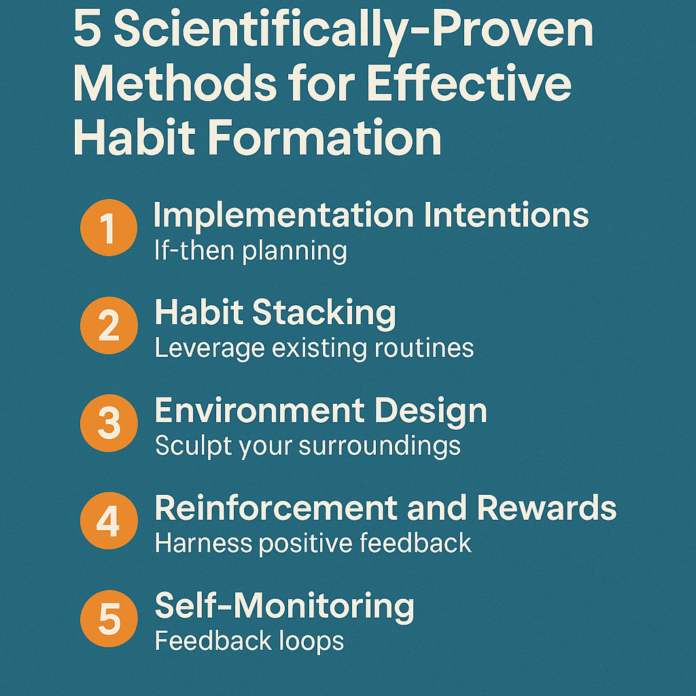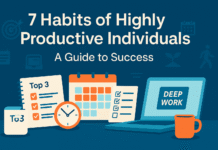In today’s fast-paced world, it can be hard to make and stick to good habits. The things we do every day have a big effect on the quality of our lives. They can make us healthier, more productive, and happier. Fortunately, decades of research in psychology and neuroscience have shown us reliable ways to change our behavior for good. This article goes into detail about five scientifically proven ways to build good habits. It gives you useful, research-backed tips on how to start new habits and keep them going for a long time.
Why It’s Important to Make Habits
Habits are the things that make behavior happen without you having to think about it. When a behavior you want to do becomes a habit, you don’t have to think about it or use willpower to do it. This lets you use your brain for other things. Researchers say that 40 to 45 percent of what people do every day is something they do on a regular basis. This shows how helpful habit-based interventions can be for both personal and professional growth. If you want to work out more often, read more, or cut down on mindless screen time, you need to know how habits are formed in order to be successful.
1. Plans for Action: “If–Then”
The Science Behind Planning
Plans for implementation intentions link a situational cue (“if”) to a behavior aimed at achieving a goal (“then”). Peter Gollwitzer was the first person to use this method, which uses the power of mental simulation to make starting actions automatic. You make a strong mental link when you plan out exactly when, where, and how you’ll do a habit. This makes you do the behavior automatically when you see the cue.
How to Use
- Get a clear signal. Choose a clear, reliable trigger, like “after I brush my teeth.”
- Please tell me what to do. Pick exactly what you will do, like “I will do ten push-ups.”
- Come up with a plan. Make it a statement that says “if this, then that”:
- If it’s 7:00 AM and I’ve brushed my teeth, I’ll do 10 push-ups.
- Imagine the execution. Think about how you will respond to the cue and then do it.
- Look at it a lot. Review your plan every day until it becomes second nature.
Key Benefit: Making plans to reach your goals can help you reach them up to 300% more than just setting them.
2. Habit Stacking: Use the Routines You Already Have to Build More Routines
In his book Atomic Habits, James Clear made the idea of habit stacking famous. It means adding a new habit to an old one. You can use routines that are already in place to help you form a new behavior by building on an already-strong neural pathway. This way of doing things is easier on your mind because your brain only has to deal with the small changes instead of starting a new habit from scratch.
What to Do
- Make a list of the things you do every day. Write down the daily things you always do, like your lunch break or your morning coffee.
- Choose a new habit that works well with the old one. After your anchor, make sure it makes sense (for example, “I will write one paragraph in my journal after my morning coffee”).
- Say something short. Use this format:
- I will [NEW HABIT] after [CURRENT HABIT].
- Start with a little thing. To keep from getting overwhelmed, start with a small habit, like writing one paragraph or doing one push-up.
- Grow slowly. Once the couple feels like they are on autopilot, make it happen more often or for longer.
Evidence of Effectiveness: A long-term study showed that chaining habits made people more consistent by more than 50% compared to trying to do habits on their own.
3. Design Your Environment: Change the Things Around You
The Importance of Context
Studies show that environmental cues can have a strong effect on behavior, even when people aren’t aware of them. You can align contextual signals with your goals by making your environment help you do the things you want to do and get in the way of the things you don’t. Charles Duhigg talks about how changing cues, like putting running shoes by the door, can change behavior in a way that is easy to predict in The Power of Habit.
Ways to Get Things Done
- Get rid of things that make it hard to do good things:
- Make it easy to get to healthy snacks.
- Put your phone in another room when you work.
- Make it harder to do bad things:
- Stop getting emails that are trying to sell you something.
- Put the remote for the TV on a high shelf.
- Make it easier to see:
- Put healthy food in see-through containers.
- Put books on display so that people will want to read them.
- Take advantage of digital tools:
- When you need to concentrate, use website blockers.
- Add reminders to your calendar.
Scientific Evidence: A behavioral economics study found that rearranging the cafeteria tables to make it easier to get to fruits led to a 25% increase in healthy choices.
4. Rewards and Reinforcement: Give Positive Feedback
Operant Conditioning in Daily Life
B.F. Skinner’s theory of operant conditioning says that behaviors that have good results are more likely to happen again. By giving rewards for progress at the right times, you create a feedback loop that strengthens the neural pathways that are linked to the habit.
How to Make Rewards Work
- Right away and very important. Choose rewards that make you feel good right after the behavior, like a five-minute break to stretch.
- Stop giving rewards from outside slowly. As automaticity grows, move toward intrinsic satisfaction, such as the feeling of accomplishment.
- Use rewards that are different each time. Sometimes, surprises (like a small treat) can be more motivating than rewards that are always the same.
- Look at how far you’ve come. Habit-tracking apps and simple paper calendars show you streaks in a way that makes your brain release dopamine.
5. Watching Yourself and Getting Feedback
The Power of Awareness
Self-monitoring means keeping an eye on what you do and writing it down. Being more aware can help you see patterns, make you want to fix your mistakes, and make you more responsible. A meta-analysis of weight-loss interventions showed that people who kept food diaries lost twice as much weight as those who didn’t.
Tools and Methods
- HabitBull, MyFitnessPal, and Streaks are all digital journals and apps that can keep track of what you do.
- Wearable devices can keep track of your steps, sleep, and heart rate without you having to do anything.
- If technology breaks down, you can use a notebook or bullet journal as a log.
- Accountability partners: Sharing your logs with friends or coaches can help you stay on track.
It’s important to get feedback: A randomized controlled trial found that people who got weekly feedback messages stuck to their exercise plans 30% more than people who didn’t get any messages.
More Advice on How to Make Changes That Last
- Start with habits that fit who you are. Say “I am a runner” instead of “I will run.” People stay motivated for a long time because of this change in identity.
- Stick to the Two-Minute Rule. It is much easier to start a habit if you do it in less than two minutes.
- Prepare for mistakes. Set up “recovery rituals” to help you get back on track quickly when things go wrong.
- Get more people to support you. You can stay accountable by joining a group, an online community, or working out with someone else.
- Think about things a lot. Make plans better by checking on progress once a month.
Frequently Asked Questions
Q1: How long does it take to get used to a new habit?
It takes different amounts of time for people to get used to a habit. It usually takes about 66 days for behaviors to become automatic, but it can take anywhere from 18 to 254 days.
Q2: What happens if I don’t show up for a day? Will the habit be broken?
No. It’s okay to mess up every now and then. It’s important to start acting again right away. Use the rule “never miss twice” to stay on track when you’re recovering.
Q3: Can these methods help you break bad habits?
Yes. Change the rules:
- Intentions for action: “I’ll chew gum if I want to smoke.”
- Get rid of things that make you want to smoke, like ashtrays, to make the space better.
- Find a better habit to replace the bad one that also gives you rewards.
Q4: Do you really need apps that keep track of your digital habits?
They help, but you don’t need them. You can also use paper logs, cross things off a calendar, or have someone else keep you accountable. Self-monitoring is the one thing that stays the same.
Q5: How do I keep my habits when I’m busy or stressed?
Make your daily life easier. Limit your habit tasks to the bare minimum, like going from 30 minutes to 5 minutes. Use “tiny habits” until you can grow again.
In the end
You need more than just willpower to keep habits going. You also need to plan ahead, set up your space, and get feedback on a regular basis. You can make your goals automatic by using scientifically proven methods like if-then plans, habit stacking, designing your environment, reinforcement, and self-monitoring. Take small steps, stick with them, and watch how they add up to big changes in yourself.
References
- Wood, W., & Rünger, D. (2016). Psychology of Habit. Annual Review of Psychology, 67, 289–314. https://doi.org/10.1146/annurev-psych-122414-033417
- Gollwitzer, P. M. (1999). Implementation Intentions: Strong Effects of Simple Plans. American Psychologist, 54(7), 493–503. https://doi.org/10.1037/0003-066X.54.7.493
- Bélanger, J. J., et al. (2014). Nicotine Dependence and Intention to Quit Smoking in Quebec High School Students. Addictive Behaviors, 39(1), 285–290. https://doi.org/10.1016/j.addbeh.2013.09.009
- Clear, J. (2018). Atomic Habits. Avery.
- Lally, P., et al. (2010). How Are Habits Formed: Modelling Habit Formation in the Real World. European Journal of Social Psychology, 40(6), 998–1009. https://doi.org/10.1002/ejsp.674
- Duhigg, C. (2012). The Power of Habit. Random House.





































[…] much of our success or failure. To create meaningful change, it’s essential to understand the science of habits and apply effective habit formation methods that allow new behaviors to take root and old, […]
[…] much of our success or failure. To create meaningful change, it’s essential to understand the science of habits and apply effective habit formation methods that allow new behaviors to take root and old, […]
[…] much of our success or failure. To create meaningful change, it’s essential to understand the science of habits and apply effective habit formation methods that allow new behaviors to take root and old, […]
[…] much of our success or failure. To create meaningful change, it’s essential to understand the science of habits and apply effective habit formation methods that allow new behaviors to take root and old, […]
[…] much of our success or failure. To create meaningful change, it’s essential to understand the science of habits and apply effective habit formation methods that allow new behaviors to take root and old, […]
[…] much of our success or failure. To create meaningful change, it’s essential to understand the science of habits and apply effective habit formation methods that allow new behaviors to take root and old, […]
[…] much of our success or failure. To create meaningful change, it’s essential to understand the science of habits and apply effective habit formation methods that allow new behaviors to take root and old, […]
[…] much of our success or failure. To create meaningful change, it’s essential to understand the science of habits and apply effective habit formation methods that allow new behaviors to take root and old, […]